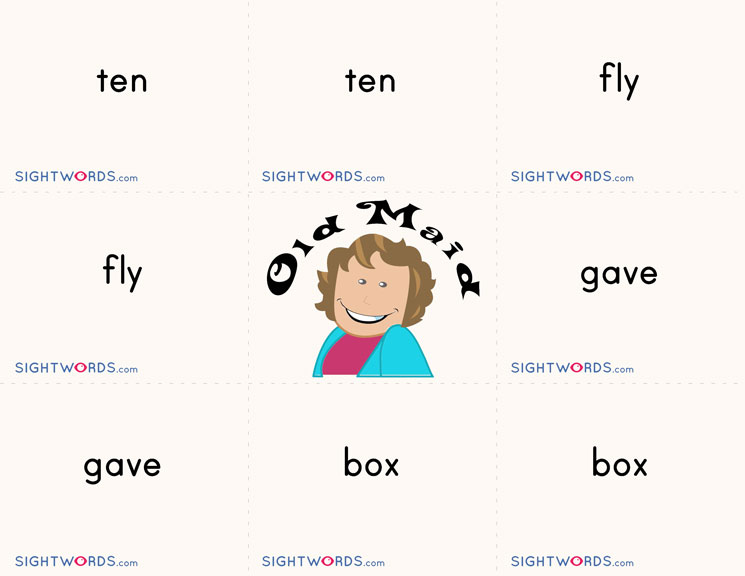Sight Words Old Maid
1. Overview
Sight Words Old Maid takes the traditional Old Maid card game and adds a sight words reading element. Instead of matching pictures, children match words to get practice and repetition while having fun.

Introducing this game is easiest when the students already have experience playing the classic Old Maid card game, because they already understand the game dynamics and can focus their attention on the reading aspect. This is of particular importance for younger children, who can get overwhelmed with having to learn a new game and new words at the same time.
Old Maid requires 2-4 players. It cannot be played individually.
2. Materials
The game requires just the Old Maid cards, which you can create on this site, to play the game.
- Old Maid Cards
- Printer
- Cardstock printer paper (approximately 110 lb / 200 gsm)
- Scissors
To create the Old Maid cards, use our online Old Maid Card Creator and print your cards onto cardstock paper. Cut out the cards. You will need all the word cards created, plus one Old Maid card.
For beginning students, you want to have a small deck (e.g., 10 word pairs plus 1 Old Maid card). For more advanced students you can expand to a larger deck (e.g., 25 word pairs plus one Old Maid card).
3. Activity
The game is played the same way as the traditional Old Maid game. Instead of matching pictures, the players match words, reading the word each time they get a matched pair. The goal is to avoid being the one holding the Old Maid card when the game ends.
Shuffle the cards and deal them all, face down, to the players. It’s OK if not everyone has the same number of cards. Everyone picks up their hand and looks for pairs of matching words. They take any matching pairs and put them aside, reading the word aloud as they discard the pair. The group checks the reading and if necessary corrects any mistakes.
This preparatory stage is a good point to help the child by having them read all the words on their cards to you. This gives them some extra practice, and gives you an opportunity to correct any reading mistakes.
Now the first player holds up their cards for the player on their right, who gets to take one of the cards. If that results in a matched word pair, then the second player reads out the word and puts the pair of cards aside. Then the second player holds up their cards for the player on their right.
The game continues like this until all the word cards have been matched, and one player is left with the Old Maid card. That player is declared the Old Maid.
4. Assessment
Sight Words Old Maid is not the best game for assessing the reading skills of individual students. But you can still make note of the children’s relative speed in reading the word cards and identifying pairs. Children who appear to be slow in finding pairs and reading the words out loud may need some extra review work.
5. Printable Old Maid Cards
You can create your own custom Old Maid Cards that incorporate words appropriate to your students’ development. As their sight reading vocabulary improves, you should decrease use of words they have mastered, and increase the use of cards for words that require more repetition for mastery.
5.1 Custom Sight Words Old Maid Cards
Use our Old Maid Card Creator to create custom Old Maid cards. This widget will generate Old Maid cards, using either Dolch or Fry Sight Words lists or your own custom vocabulary words.
5.2 Blank Old Maid Cards
5.3 Dolch Sight Words Old Maid Cards
6.4 Fry Sight Words Old Maid Cards
- 1st 100 Fry Words
(100 words) - 2nd 100 Fry Words
(100 words) - 3rd 100 Fry Words
(100 words) - 4th 100 Fry Words
(100 words) - 5th 100 Fry Words
(100 words) - 6th 100 Fry Words
(100 words) - 7th 100 Fry Words
(100 words) - 8th 100 Fry Words
(100 words) - 9th 100 Fry Words
(100 words) - 10th 100 Fry Words
(100 words)
To download a template, right-click and select Save As.
The Sight Words Old Maid Cards are provided under the Creative Commons Attribution 3.0 Unported License. Basically, you are permitted complete license to use the resources, provided you leave the attribution hallmark (our logo) on the resources. We would be happy to see the materials used in the classroom, in the home, as part of your tutoring business, or however you see fit. You do not need to contact us for permission to use the materials. We want you to use them!
Leave a Reply
